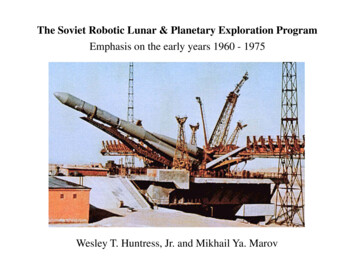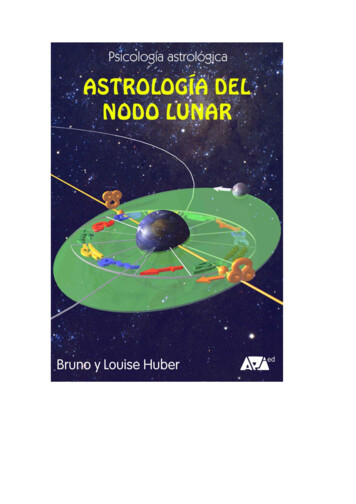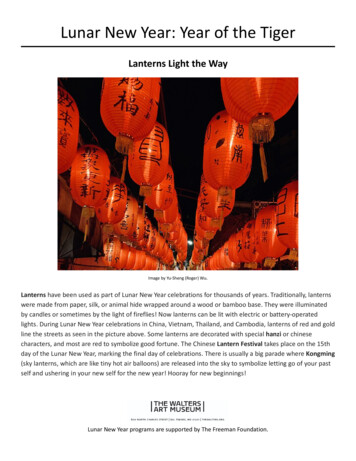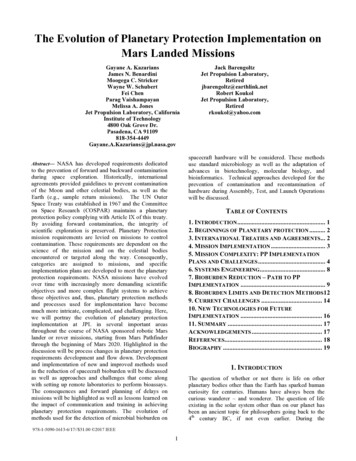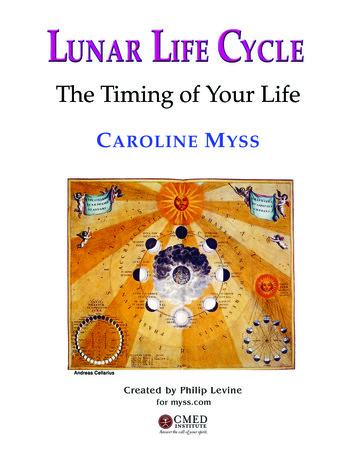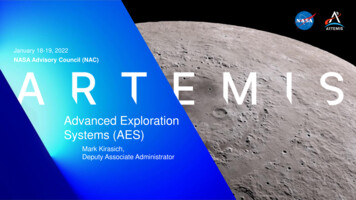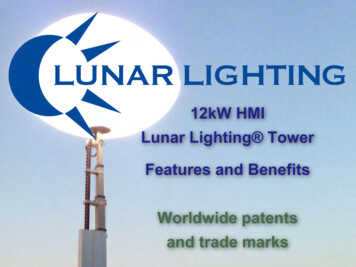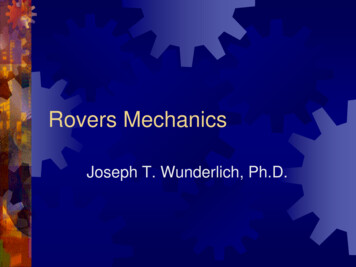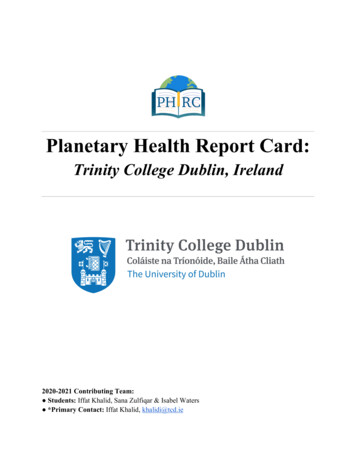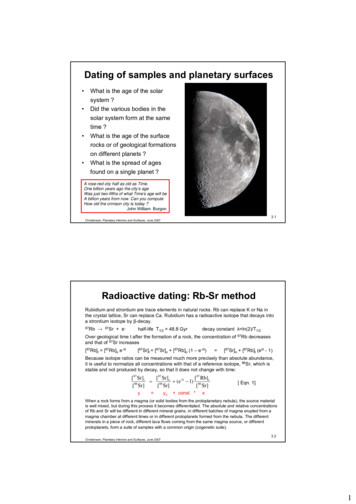
Transcription
Planetary Science:A Lunar PerspectiveSTUART ROSS TAYLOR
The Moon depicted in apainting by Donato Creti. Oil on canvas,1711. [ edini,S . A. (1980) PLC 11: xiii.] Courtesy the VaticanMonumenti, Musei e Gallerie Pontificie. This illustrates the stateof planetary observation at the beginning of the eighteenth century. Most of the succeeding advances in thisfield have occurredin the past decade.
Planetary Science:A Lunar PerspectiveSTUART ROSS TAYLORLunar and Planetary InstituteHouston, Texas, U.S.A.andResearch School of Earth SciencesAustralian National UniversityCanberra, AustraliaLUNARAND PLANETARYINSTITUTE3303 NASA ROAD 1HOUSTON, TEXAS 77058
Copyright@1982 by the Lunar and Planetary Institute.This work relates to N A S A Contract No. NASW-3389 with Universities SpaceResearch Association. The U.S. Government has a royalty-free license to exercise allrights under the copyright claimed hereinfor Governrnentalpurposes. All other rightsare reserved by the Lunar and Planetary Institute.Typeset by the Lunar and Planetary Institute, printed by Publishers ProductionInternational, and bound by Arnold's Bindery in the United States of America.Library of Congress Cataloging in Publication Data available from the Library ofCongress CIP Division, or from the publisher.Cover: A n artistic perception of aportion of Mare Ingenii (S.Adlis- Vass, artist).Back cover: A n artistic rendition of the view south acrossMare lmbriurn (S. Adlis- Vass, artist).
ToNoelSusanna, Judith and Helen
PrefaceThe technical triumph of manned landings on the Moon and thereturn of samples from the lunar surface has provided scientists with aunique opportunity to advance our understanding of the nature, evolutionand origin of the solar system. The nine suites of samples recovered by theApollo and Luna missions have provided so many answers that it is nowdifficult to recall our state of ignorance before July, 1969. The new knowledge is contained in a massive outpouring of scientific literature, conservatively estimated at 18,000 articles which have appeared in the past decade.In a previous book, I attempted to survey and comprehend the state oflunar science at the close of the active period of lunar exploration. Thatwork records the state of lunar science as of April, 1974, following the evaluation of the results from the final manned mission, Apollo 17, inNovember, 1972. In that book, I was concerned with extracting the evolutionary history of the Moon from the great mass of data on the lunar samples. The story as recorded in Lunar Science: A Post-Apollo View hassurvived reasonably well. Many new data have appeared, new models havebeen proposed, and refinements of existing models have been carried out.No substantial reason exists to attempt the essentially minor changes of asecond edition: instead I have adopted the maxim "what I have written, Ihave written" [I], letting the work stand as a statement of lunar science atthat time, and I have essayed a new approach.In 1974, only early results from other planets were available. Now aconsiderable advance in our knowledge of the solar system has occurredand I have attempted to extend the knowledge gained from the lunar datato provide some insights into this wider sphere, Accordingly, I have usedthe lunar story as a basis for understanding the origin and evolution of thesolar system. In the early days of the manned missions, the term "RosettaStone" was often used. In a sense, the usage is correct. The study of thelunar samples has proven to be a key to understanding, for example, muchabout meteorites. The Moon remains the only body which we have visitedand sampled with a proper understanding about the relation of the samplesto the overall evolution of the planet. The Moon, as revealed from thosestudies, is sufficiently different from the Earth, both to render terrestrialanalogies hazardous, and to provide another example of planetary differentiation processes. The tendency to regard the Earth as a norm, and terrestrial geochemical processes as a model for those on other planets, has notsurvived the encounter with the lunar data. Many details, such as the contrasting behavior of chromium on the two planets, have provided salutarywarnings of the hazards of extrapolating from one planet and of the problems of the statistics of small numbers. The same warning applies to thelunar samples. Accordingly, I have tried to utilize the lunar data along with
our long terrestrial experience to provide a synthesis. The subject matterand treatment is heavily biased toward the lunar data, since these haveprovided the major advance in our understanding of planetology.Some of the information given in the previous book has changed littlesince 1974, and it has proven necessary to retraverse some familiar ground.For example, the lunar stratigraphic sequence was already well established,and only the subdivision of the Pre-Imbrian into Nectarian and PreNectarian is new. Some of the same figures have been reused. The beautifulearth-based lunar photographs taken by the Lick Observatory have neverbeen surpassed and it seemed pointless to replace them. They are stillworthy of study, for our spacecraft photographs of many planets and satellites are at about the same resolution. The reconstructions of the lunar surface in previous ages by Davis and Wilhelms reappear for similar reasonsand there are a few other similar instances throughout the book. In somedisciplines, such as organic geochemistry, no significant new material hasappeared, and the reader is referred to the previous text for enlightenment.During the writing of Lunar Science: A Post-Apollo View, a verylarge number of questions about the Moon had not been resolved, andwere the subject of intense debate. Thus the question of whether water waspresent on the Moon was under consideration; the nature of the regolithforming processes awaited proper study of the core tubes. The questions oforigin of the Cayley Formation and light plains deposits, and of whethervolcanism existed in the highlands continued to persist. The compositionand origin of the highland crust was a major problem. Possibly, it had beenadded to the Moon like a coat of plaster. Although the volcanic versusimpact debate over the origin of the craters had been resolved before thelandings, the formation of multi-ring basins was in dispute. The origin ofmare basalts, whether from primitive or cumulate sources, was under activediscussion, together with the question of the origin of the europium anomaly. There were still questions about model age interpretations. No Sm-Nddata were available. These were first reported in March, 1975, at the 6thLunar Science Conference and immediately disposed of single-stage modelsfor mare basalt genesis. Whether the Moon had been wholly melted, or notmelted at all, was also a matter of dispute. The solar nebula was generallyheld to have been isotopically homogeneous with the data from the oxygenisotopes just beginning to suggest otherwise. Thus the intellectual climate inwhich the book was written was very different from that of today. It was atthe time a fascinating intellectual exercise to judge among the many competing explanations, particularly when they lay outside my own specialty.Further analyses of the lunar samples have resolved many of the problems listed above, but a number remain unsolved. Many questions sufferfrom lack of sufficient resolution in the data, a problem which may bereferred to as the "Martian Canal Syndrome."
As in the previous book, the emphasis is on interpretation and synthesis. The Moon appears particularly well suited t o this type of approach. Ithas a comparatively simple history, and responds well t o large-scale overviews. The Moon is built on a large scale. The infinite complexity of somelunar samples such as the highland breccias is due to the repeated effects oflarge impacts, a comparatively simple concept, although the effects arecomplex.I have avoided the temptation t o include much about the Earth in thisbook, for various reasons: (a) the amount of information available is huge;(b) adequate treatment would demand so much space that it would be difficult to d o justice to the subject and avoid swamping the data from theother planets and satellites; (c) the surficial geology, volcanic landforms,plate tectonic mechanisms and much else, including the atmosphere andhydrosphere, are unique to this planet and cannot be addressed adequatelyin the space available; and (d) our insights into the composition, structureand evolution of the core, mantle and crust are in many ways at a n earlystage. Much work remains to be carried out on the significance of the traceelement and isotopic evolution of the mantle. In this context, the picture oflunar evolution which has emerged has provided new insights into the earlyhistory of the Earth. Occasionally I have been unable t o resist commentingon various aspects, such as the development of the continental crust andthe bulk composition of the terrestrial mantle (Chapter 8), which form a nimportant constraint on our ideas of planetary evolution, and on the relationship between the Earth and the Moon. Finally, the origin of the Earthis addressed briefly in Chapter 9.The problems in dealing with the information from the other planetsand satellites are large. Those workers who have expected more insights onplanets other than the Moon should recall that our knowledge of thesebodies is comparable to that of the Moon in the pre-Apollo era. There isexcellent photography, some geophysical data and a little chemistry fromremote samplers. The analogy with the data base for the Moon in 1968-69is nearly complete.Our experience with the lunar samples was salutary and informed usthat much of our pre-mission thinking was in error. This is a commonsituation in science. In a book such as this, concerned with the scientificresults of the space program, we must be cautious not t o push the databeyond the limits of resolution, and so fall into Martian canals or dustfilled maria.The quality of the photographs returned from the Pioneer, Mariner,Voyager and Viking missions has provided one of the more aesthetic experiences of the age. Analogies with the heroic period of the early terrestrialnavigators are appropriate. Perhaps the beauty and strangeness of the surfaces of the planets and satellites will prompt a new literary o r poetic flow-
ering. We must not let those excellent pictures deceive us into believing thatwe fully understand all that is visible or, by extrapolation, that we comprehend the nature of the planets or satellites. This phase of exploration is apreliminary, rather than a terminal phase. The appropriate analogy is withthe pre-Apollo and pre-Surveyor stages of lunar exploration. The Ranger,Orbiter and Russian photographs of the lunar surface resolved only a fewquestions about the nature of the lunar surface. "Information was limitedto the images and once again it was demonstrated that a surface cannot becharacterized by its portrait . . . the heightened resolution of the picturesdid not resolve the arguments. The moon remained inscrutable at allscales" [2]. "It is evident that pictures of strange material in a strangeenvironment do not lead to unique deductions as to composition" [3].These cautionary tales are to remind us that our knowledge of the othermembers of the solar system is similar to our pre-Apollo understanding ofthe Moon. This is a reason for continued exploration at an enhanced level,including sample return. Accordingly, in this book, which is biased towardcosmochemistry, I have emphasized the lunar data, despite many temptations to extrapolate beyond our present understanding of the other planetsand satellites.Meteorites provide unique and crucial evidence on early conditions inthe solar nebula, and the lunar data have shed much light on previouslyobscure problems. It is, however, not possible in a book of this length tomake more than passing reference to them, mainly in Chapters 8 and 9.Theories for the origin and evolution of the solar system must accommodate the new meteoritic evidence, which demands book-length treatment inits own right.The very large body of literature has called for much selection and evaluation. I have attempted to provide a synthesis, rather than a catalogue,believing the former approach to be of greater service to the reader.Accordingly, I have had to make various choices among competing modelssuch as on the questions of the existence of lunar cores, terminal cataclysms, magma oceans, KREEP volcanism, hot or cold nebulae, planetesimals or gaseous protoplanets, and many other fascinating but hazardousexercises. I have been fortified in these endeavors by discussions with thesuperb body of lunar scientists [4] who form an imposing tribute to therational methods of scientific inquiry.I have tried generally to reference the latest comprehensive statementson particular topics. I have also attempted to list references to all sourcesof fact, information, opinion and interpretation other than my own. It isessential in a book of this kind both that a proper perspective be presentedand that appropriate formal referencing be attempted. Unsupported statements amount to expressions of dogma, acceptable in works on science fiction, astrology, religion, paranormal phenonoma, extra-sensory perception
and the occult, but not, since the Renaissance, in scientific literature, Bookswhich are commonly not subject to peer review processes may occasionallyfall into such a credibility trap [ 5 ] . Accordingly, I have attempted bothextensive referencing and a measure of peer review [4].The number of references cited has led, as in the previous book, to theuse of an abbreviated style of referencing. It is not practical in a work ofthis size to cite the fully expanded reference for each paper. Since many ofthe references are to the Proceedings of the Lunar and Planetary ScienceConferences, an enormous amount of repetition would occur. One of theaims of this book is to serve as an introduction to the lunar literature, sothat the interested reader can pursue any topic in depth and consult theoriginal references. The numbered references at the end of each chaptercontain (1) authors names (where there are more than two, the initialauthor followed by et al., is used); (2) year; (3) abbreviated journal orbook title; (4) volume number; (5) initial page number or page numberquoted. This provides enough information to enable the reference to bequickly located. Full referencing details including the journal titles aregiven in Appendix I. In Appendix 11, a list of primary data sources is given.I have tried to avoid references to unrefereed papers, internal reports andother "grey" literature, but sometimes this has been unavoidable.In a book of this size, it is difficult to include an extensive data base.As an example, the recent treatise on Basaltic Volcanism on the TerrestrialPlanets runs to over 1300 pages on a topic which I have treated in onechapter. Some of the material which I prepared for use in that book hasbeen incorporated in this text with minor amendments.I have attempted not to dwell excessively on facts which are wellknown and widely accepted, but have devoted more space to the controversial aspects of the subject. This carries the risk of producing some imbalance in the book, but I have judged it more profitable to adopt thisapproach rather than to inflict tedious descriptions of well-known materialwhich is readily available in other sources.The literature coverage extends to November, 1981, including references to the Multi-ring Basin Conference, the Apollo 16 Workshop, the Proceedings of Lunar and Planetary Science Conference, 12B, and to BasalticVolcanism on the Terrestrial Planets. All radiometric age dates have beenrecalculated in terms of the new decay constants [6].Stuart Ross TaylorHouston and CanberraNovember, 1981
References and Notes1.2.3.4.5.6.Pontius Pilate (The Gospel according to St. John, 19:22, King James Version).Scott, R. F. (1977) Earth Sci. Rev. 13: 379.Urey, H. C. (1966) Science. 153: 1420.See Acknowledgments.See for example Smith, J. V. (1980) J. Geol. 88: 250.See Chapter 6, reference [105].
The AuthorStuart Ross Taylor, M.A., D.Sc. (Oxford), M.Sc. (N. Z.), Ph.D. (Indiana), F.A.A., is a Professorial Fellow at the Research School of EarthSciences, the Australian National University. Dr. Taylor has carried outextensive investigations in lunar and terrestrial trace element geochemistry,including research work on analytical techniques, the composition and evolution of the continental crust, island-arc volcanic rocks, tektites, meteoriteimpact glasses, lunar samples and models for the geochemical evolution of theMoon. He has published 170 scientific papers and three books, includingLunar Science: A Post-Apollo View (Pergamon, 1975).Dr. Taylor was a member of the Lunar Sample Preliminary ExaminationTeam (LSPET) for Apollo 11 and 12 and carried out the first chemicalanalysis of a lunar sample. He is a Principal Investigator for the lunar sampleprogram and a Fellow of the Meteoritical Society and of the AustralianAcademy of Science. He is an editor of Geochimica et Cosmochimica Actaand Chemical Geology.
AcknowledgmentsThis book was written over a period of fourteen months (October 1980November 1981), principally at the Lunar and Planetary Institute, Houston. Iam grateful to Dr. Roger Phillips, Institute Director, for enabling me to workfor extended periods in Houston, providing access both to the library and datafacilities and the Johnson Space Center, and to a wide spectrum of lunarscientists.I owe, as d o all workers in planetary research, an initial debt to HaroldUrey and Ralph Baldwin for their early and perceptive insights, which set theintellectual stage for planetary exploration. A further tribute is due to thescientists of the lunar and planetary community on whose work this book isbased. During the past decade, I have had fruitful discussions with innumerable individual scientists, and have formed many lasting friendships, so that itis difficult to single out those who have made a special contribution. I amgrateful to them for the encouragement to write this book. This body ofscientists, interdisciplinary and international, can deal competently with anycurrent scientific observation in the solar system and is perhaps the greatestbenefit to have come from the space program.Books have long been considered as an authoritative source of information, but unless subject to peer review, may commonly reflect the prejudices of the author. Some bias is inevitable, but I have attempted to avoid thistrap by prevailing upon several scientists to read chapters dealing with theirown specialties. Dr. Don E. Wilhelms has read Chapter 2 on geology andChapter 3 on cratering. Dr. Fred Horz also read Chapter 3 and Chapter 4 onplanetary surfaces. Professor Larry Taylor has read Chapter 5 on planetarycrusts and Dr. David Walker, Chapter 6 on basaltic volcanism. Chapter 7,which deals with many geophysical aspects, has been read by Dr. RogerPhillips, Dr. Len Srnka and Dr. Michael McElhinny. Professor J . V. Smithread both Chapter 8 on planetary compositions and Chapter 9 on the originand evolution of the solar system.I am exceedingly grateful to these workers for their time and patience intoiling through rough draft material. Their comments have substantiallyimproved the text, and saved me from various grievous errors. The responsibility for interpretations, shortcomings and errors remains my own.
The production of this book on a short time scale would not have beenpossible without the aid and help of the staff of the Lunar and PlanetaryInstitute. Rosanna Ridings, Managing Editor, contributed greatly t o theefficient editing and production of this book. She was ably assisted by DoryBrandt, Kelly Christianson, Renet: Edwards, Lanet Gaddy and Donna Theiss.The preparation of the figures was carried out with artistic skill by DonnaJalufka-Chady, Sharon Adlis-Vass, and David Powell, with S. Adlis-Vassacting as lead designer. Carl Grossman, assisted by Gayle Croft, was responsible for the typesetting of the book. Production of final pages was coordinated by Pamela Thompson. Ron Weber was responsible for supplying muchof the photographic material. Jack Sevier read over the entire text. FranWaranius placed the excellent and essential facilities of the library freely at mydisposal. In Canberra, Gail Stewart typed many preliminary drafts with speedand precision.Many colleagues have supplied illustrative material. The length of the listand the diversity of scientific disciplines represented is a tribute t o the interdisciplinary nature of the subject. I a m grateful for the help of the followingindividuals:I. AdlerE. AndersC. G. AndreR. N. ClaytonJ. W. DelanoR. A. F. GrieveW. K. HartmannJ. W. HeadB. R. HawkeF. HorzR. M. HousleyJ. S. HuebnerR. L. KovachJ . LonghiG. W. LugmairI. S. McCallumJ . F. McCauleyD. S. McKayG. A. McKayA. L. MetzgerJ. W. MorganJ. B. MurrayL. E. NyquistM. NormanJ . J. PapikeR. J . PhillipsC. M. PietersJ. B. PikeS. PullanL. RaedekeD. J. RoddyC. T. RussellG . RyderM. SatoR. S. SaundersJ. V. SmithS. C. SolomonD. StofflerR. G. StromL. A. TaylorG. J . Wasserburg
A particular acknowledgment is due to Dr. Robin Brett, who ensured myinitial participation in lunar studies.Acknowledgment is made to the following for permission to use copyrighted material:Anglo-Australian Observatory (Fig. 9.1)Cerro Tololo Inter-American Observatory (Fig. 9.2)Lick Observatory (Figs. 2.1, 2.2, 2.4, 2.7, 6.9a)Scientific American (Fig. 9.3)The National Aeronautics and Space Administration (NASA) providedthe initial sample material, collected with care and expertise, which has madepossible the writing of this book. Additional support for the writing of thisbook was provided through NASA Contract No. NASW 3389, made possibleby the kind efforts of Dr. William L. Quaide of NASA.
CONTENTSPrefaceAcknowledgmentsChapter1.11.21.31 The Exploration of the Solar SystemEarly InfluencesLunar SamplingThe Moon and the Solar SystemReferences and NotesChapter 2 Geology and Stratigraphy2.1 The Face of the Moon2.2 Stratigraphy of the Lunar Surface2.3 Radiometric and Stratigraphic Lunar Time Scales2.4 Detailed Lunar Stratigraphy2.4.1 Pre-Imbrian2.4.2 Pre-Nectarian2.4.3 Nectarian2.4.4 The Imbrian System2.4.5 Eratosthenian System2.4.6 Copernican System2.5 Mercury2.5.1 Intercrater Plains2.5.2 The Heavily Cratered Terrain2.5.3 Smooth Plains2.5.4 Lobate Scarps2.6 Mars2.6.1 The Ancient Cratered Terrain2.6.2 Volcanic Plains and Mountains2.7 Venus2.8 Gallilean and Saturnian SatellitesReferences and NotesChapter 3 Meteorite Impacts, Craters and Multi-Ring Basins3.1 The Great Bombardment3.2 The Volcanic/Meteorite Impact Debate3.3 The Mechanism of Crater Formation3.4 Simple Bowl-Shaped Impact Craters3.5 Large Wall-Terraced Craters, Central Peaks and Peak Rings
e Multi-Ring BasinsDepth of Excavation of BasinsBasin Diameter-Morphology RelationshipImpact Melts and Melt SheetsSecondary Impact CratersDark-Halo CratersSmooth-Rimmed Craters and Floor-Fractured CratersIsostatic Compensation of CratersLinne Crater and Transient PhenomenaSwirlsMeteorite FluxThe Cratering Record and the Lunar CataclysmSecondary Cratering and the Cayley ProblemReferences and NotesChapter 4 Planetary Surfaces4.1 The Absence of Bedrock4.2 The Extreme Upper Surface4.3 The Regolith4.3.1 Thickness and Mechanical Properties4.3.2 Structure4.3.3 Rate of Accumulation4.3.4 "Ages" of the Soils4.3.5 Soil Breccias and Shock Metamorphismof Lunar Soils4.4 Glasses4.4.1 Agglutinates4.4.2 Impact Glasses4.4.3 Tektites4.5 Chemistry and Petrology of the Regolith4.5.1 Metallic Iron in the Lunar Regolith4.5.2 Volatile Element Transport on the Lunar Surface4.5.3 The Meteoritic Component4.6 Microcraters and Micrometeorites4.7 Irradiation History of the Lunar Surface4.7.1 Solar Wind4.7.2 Solar Flares4.7.3 Galactic Cosmic Rays4.8 Physical Effects of Radiation4.9 Chemical and Isotopic Effects4.9.1 Carbon, Nitrogen and Sulfur4.9.2 The Rare Gases
4.9.3 The Argon-40 Anomaly4.9.4 Cosmogenic Radionuclides4.9.5 Thermal Neutron Flux4.10 Exposure Ages and Erosion Rates4.10.1 Nuclear Track Data4.10.2 Rare Gas Data4.11 Solar and Cosmic Ray History4.12 The Lunar Atmosphere4.13 Rare Gases and Planetary Atmospheres4.14 Organic Geochemistry and ExobiologyReferences and NotesChapter 5 Planetary Crusts5.1 The Lunar Highland Crust5.1.1 Thickness and Density5.1.2 The Megaregolith5.2 Breccias5.2.1 Monomict Breccias5.2.2 Dimict Breccias5.2.3 Feldspathic Fragmental Breccias5.2.4 Impact Melt Breccias5.2.5 Granulitic Breccias5.2.6 Basalts in Highland Breccias5.3 Melt Rocks5.4 Highland Crustal Components5.4.1 Anorthosites5.4.2 The Mg Suite5.4.3 KREEP5.4.4 KREEP Volcanism in the Lunar Highlands?5.5 Volatile Components in the Highland Crust5.6 The Ancient Meteorite Component5.7 Pristine Rocks in the Lunar Highlands5.8 The Orbital Chemical Data5.9 The Chemical Composition of the Highland Crust5.9.1 Element Correlations5.9.2 Highland Crustal Abundances5.10 Age and Isotopic Characteristics of the Highland Crust5.10.1 The Oldest Ages5.10.2 The 4.2 Aeon Ages5.10.3 Basin Ages and the Lunar Cataclysm5.11 Evolution of the Highland Crust5.11.1 The Magma Ocean
5.11.2 How Long did the Early Highland CrustTake to Evolve?5.11.3 Crystallization History of the Lunar Crust5.12 The Crust of the Earth5.13 Other Planetary CrustsReferences and NotesChapter 6 Basaltic Volcanism6.1 Floods of Basaltic Lava6.1.1 Thickness of Mare Fill6.1.2 Age of the Oldest Mare Surface6.1.3 The Lunar Lava Flows6.1.4 Dark Mantle Deposits6.1.5 Domes and Cones6.1.6 Ridges6.1.7 Sinuous Rilles6.1.8 Straight and Curved Rilles6.2 Mare Basalt Rock Types6.2.1 Mineralogy6.2.2 Reduced Nature of Mare Basalts6.2.3 Volcanic Glasses6.3 Chemistry of Mare Basalts6.3.1 Major Elements6.3.2 Large Cations6.3.3 Rare-Earth Elements and theEuropium Anomaly6.3.4 High Valency Cations6.3.5 The Ferromagnesian Elements6.3.6 Sulfur and the Chalcophile Elements6.3.7 The Siderophile Elements6.3.8 Oxygen and Carbon6.4 Ages and Isotopic Systematics of the Mare Basalts6.4.1 The Commencement of Mare Volcanism6.4.2 Radiometric Ages for the Mare Basalts6.4.3 Isotopic Indexes of Mantle Heterogeneity andBasalt Source Ages6.5 Origin of the Mare Basalts6.6 Cooling and Crystallization of the Lavas6.6.1 Primary Magmas6.6.2 Fractional Crystallization6.7 The Record Elsewhere6.7.1 Mercury-Are Basalts Present?
6.7.2 Mars6.7.3 Venus6.7.4 106.7.5 VestaReferences and NotesChapter 7 Planetary Interiors7.1 The Advantages of Geophysics7.2 Radii, Densities and Moments of Inertia7.3 Lunar Center of Mass/Center of Figure Offset7.4 r a v i t 7.4.1 Lunar Gravity7.4.2 The Mascons7.4.3 Mars7.4.4 Venus7.5 Seismology7.5.1 The Lunar Record7.5.2 The Martian Record7.6 Internal Structures7.6.1 The Moon7.6.2 A Lunar Core?7.6.3 Mars, Venus and Mercury7.7 Heat Flow and Internal Temperatures7.7.1 Heat-Flow Data7.7.2 Electrical Conductivity7.7.3 The Lunar Temperature Profile7.8 Magnetic Properties7.8.1 Lunar Magnetism7.8.2 Remanent Magnetism7.8.3 Lunar Magnetic Field Paleointensities7.8.4 Crustal Magnetic Anomalies7.8.5 Origin of the Lunar Magnetic Field7.8.6 Planetary Magnetic FieldsReferences and NotesChapter 8 The Chemical Composition of the Planets8.1 The New Solar System8.2 The Type 1Carbonaceous Chondrites ( C l )8.3 The Earth8.3.1 Primitive Mantle (Mantle Plus Crust)8.3.2 The Crust8.4 The Moon
8.4.1 The Highland Crust8.4.2 The Mare Basalts8.4.3 Bulk Moon Compositions8.4.4 Earth-Moon Comparisons8.5 The Planets8.6 Meteorite Parent Bodies and SatellitesReferences and NotesChapter 9 The Origin and Evolution of the Moon and Planets9.1 The Beginning9.2 Initial Conditions in the Solar Nebula9.3 Primary Accretion Models and "Condensation"in the Nebula9.4 Variations Among Refractory, Volatile,Chalcophile and Siderophile Elements9.5 Early Solar Conditions9.6 Secondary Accretion Process9.7 Formation of the Moon9.8 The Formation of the EarthReferences and NotesChapter 10 The Significance of Lunar and PlanetaryExploration10.1 The Lunar Experience10.2 Future Missions10.3 Man's Responsibility in the UniverseReferences and NotesAppendix IReference AbbreviationsAppendix 11Lunar Primary Data SourcesAppendix I11Diameter and Location of Lunar Craters Mentioned in the TextAppendix IVLunar Multi-ring BasinsAppendix VTerrestrial Impact CratersAppendix VIAppendix to Table 8.1: Sources of Data
Appendix VIIElement Classification, Condensation SequencesAppendix VIIIChondritic Rare EarthAppendix IXThe Lunar Sample Numbering SystemAppendix XPlanetary and Asteroidal DataAppendix XISatellite DataGlossaryIndex
important constraint on our ideas of planetary evolution, and on the rela- tionship between the Earth and the Moon. Finally, the origin of the Earth is addressed briefly in Chapter 9. The problems in dealing with the information from the other planets and satellites are large. Those workers who have expected more insights on
